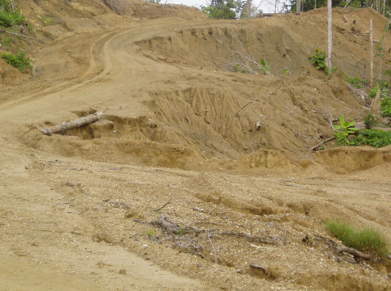Module 3: Biodiversity and Ecosystem Service Values of Natural Forest
Topic 3.2: Ecosystem Services
Forests perform a variety of ecological services (e.g., watershed protection and carbon sequestration) that are of local, regional, and global concern. Because the capacity of forests to perform these services can be influenced by timber harvesting and other silvicultural operations, forest managers need to be acutely aware of the impacts of their prescriptions.
Hydrology
Forests influence the quantity, quality, and seasonality of water both on the surface and in subsurface aquifers. For example, by intercepting moisture from clouds and mist, forests can increase water inputs 30-150%. Many montane forests are important trappers of this “horizontal rain” and clearing them can greatly diminish stream flows from high elevation water catchments. On the other hand, because a great deal of water is transpired by canopy trees and vines, and their leaves and branches intercept rainwater that then evaporates without reaching the ground, forest can also reduce streamflow. [BOX 2.1. The eucalyptus debate.] Whether the total amount of water flowing from a catchment is increased or decreased, forests tend to moderate the fluctuations in streamflow by reducing peak flows after storms and maintaining high basal flows during dry periods. Furthermore, because forest litter protects surface soil particles from being dislodged by raindrops, increases soil organic matter and water infiltration rates, and thereby decreases the amount of surface flow, the presence of forests tends to increase recharge rates of subsurface aquifers and to decrease soil erosion. Water emerging from forested catchments is therefore generally of higher quality and keeps flowing longer into dry periods than that from catchments that have been disturbed by uncontrolled logging or cleared for agriculture. These beneficial effects of forests are enjoyed throughout the watershed and out to sea where coral reefs and other near-shore ecosystems can be damaged by heavy sediment loads from deforested catchments.


Figure 3.2.1. A log-stringer bridge with soil abutments (left). A failed bridge that will deliver a large amount of sediment into the creek, which is may temporarily impound (right)
For predicting the amount of soil loss under different climatological regimes, vegetation types, and land-uses, hydrologists use what is known as the Universal Soil Loss Equation. Actually, it is not one equation at all, but rather a series of equations modified to suite local conditions by changing the values of at least the following parameters: rate of precipitation; slope; slope length; size of catchment; tortuosity of the pathways followed by surface-flowing water; soil water content; and, water infiltration rates. Forest managers can manipulate these factors in numerous ways to reduce soil erosion in numerous ways such as by avoiding construction of roads and skid trails on steep slopes, reducing the size of micro-catchments on roads by installing drains at frequent intervals, and protecting surface soil from compaction.



Figure 3.2.2. Hydrological problems indicated by a stream with a high sediment load (top left) due to runoff from compacted soil (top right), and a poorly constructed hauling road (bottom).
Nutrient cycling
By holding nutrients in living biomass and necromass (i.e., fallen logs, leaf litter, and etc.) and by rapidly absorbing nutrients when they are released from decomposing organic matter, forests tend to cycle nutrients in a very efficient manner. Although some nutrients are lost from even the most pristine old-growth forests, they are generally replenished by release from parent rocks and by atmospheric inputs in windblown dust and rain.
Forest management operations generally do not greatly disrupt nutrient cycles unless they are improperly designed or implemented. If the soil is not compacted or otherwise disturbed and most of the biomass and necromass are left intact, as is generally the case in natural forest management for timber and non-timber forest products, it might be difficult to detect any changes at all in nutrient cycling. Only where harvesting intensities are high and are carried out on extremely oligotrophic (=nutrient-poor) soils is replenishment of removed nutrients a potentially serious problem.
Carbon sequestration and climate control
Forests have important effects on local, regional, and global climates. The cooling effects of individual trees are known to all of us. Trees in towns and cities also serve to improve air quality by removing particulate matter. Less obvious but nonetheless real are the regional impacts of extensive forest clearing. Studies in the Amazon Basin and in Southeast Asia have revealed that water evaporating from forests can be the source of a large proportion of local rainfall. When large tracts of forest are cleared, droughts tend to be more frequent and more severe.
Globally tropical forests store huge quantities of carbon; deforestation and forest degradation due to wildfires and logging are responsible for about 30% of the annual human-induced additions to the atmosphere of carbon dioxide and other “greenhouse” gases. Increased concentrations of greenhouse gases are associated with global warming and attendant sea level rise, both of which are massive problems of global concern. Improved management of tropical forests and reforestation of deforested areas could help to reduce the global warming problem at a fraction of the financial costs associated with changing technologies in the energy and manufacturing sectors. Obviously, the best way to reduce global warming would be for the developed countries of the world to stop burning excessive amounts of fossil fuels, but funds from forest-based “carbon offset” projects can serve to help motivate the change to more environmentally sound forestry.
